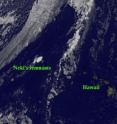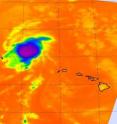Tropical Depression Neki nulled by cool waters and wind shear
Two ingredients that don't mix well with tropical cyclones are waters cooler than 80 degrees Fahrenheit and wind shear. Those two ingredients were added into Tropical Depression Neki's mix late yesterday, and caused Neki to dissipate. The Geostationary Operational Environmental Satellite called GOES-11 captured a look at Neki's remnants this morning, October 27 at 8 a.m. EDT. Neki appeared as an ill-defined, elongated swirl of low clouds. The Central Pacific Hurricane Center (CPHC) noted that Neki "Appears to be just a surface trough in satellite imagery."
Last night, October 26 at 5 p.m. HST (11 p.m. EDT) the Central Pacific Hurricane Center issued their final advisory on Neki. At that time, Neki was a depression with maximum sustained winds near 35 mph. Neki's last location was 450 miles north of French Frigate Shoals, or 665 miles north-northwest of Lihue, Hawaii, near 30.3 North and 164.9 West. The depression had a minimum central pressure of 1010 millibars and was speeding north-northeast near 36 mph!
NASA's Aqua satellite AIRS instrument captured an infrared image of Neki's clouds on October 26 at 8:35 a.m. EDT. Neki appeared as a round area of clouds on infrared imagery, was devoid of any strong convection.
The CPHC said that "Decreasing sea surface temperatures along [Neki's northeastern] track and increasing vertical [wind] shear should prevent redevelopment as a tropical cyclone."
Source: NASA/Goddard Space Flight Center
Articles on the same topic
- NASA gets a 3-D look at Neki becoming extra-tropicalMon, 26 Oct 2009, 20:18:52 UTC
- NASA satellite still sees heavy rainfall in Tropical Storm NekiFri, 23 Oct 2009, 20:57:03 UTC
- NASA's TRMM sees some heavy rains in Neki as it heads toward Johnston IslandTue, 20 Oct 2009, 20:08:34 UTC
- 2 NASA satellites see Tropical Storm Neki form in the Central PacificMon, 19 Oct 2009, 22:07:34 UTC
Other sources
- Tropical Depression Neki nulled by cool waters and wind shearfrom PhysorgTue, 27 Oct 2009, 19:49:29 UTC
- NASA gets a 3-D look at Neki becoming extra-tropicalfrom PhysorgMon, 26 Oct 2009, 20:14:19 UTC
- NASA satellite still sees heavy rainfall in Tropical Storm Nekifrom PhysorgSat, 24 Oct 2009, 11:07:07 UTC
- NASA satellite still sees heavy rainfall in Tropical Storm Nekifrom Science BlogSat, 24 Oct 2009, 2:28:27 UTC
- NASA satellite still sees heavy rainfall in Tropical Storm Nekifrom Science BlogFri, 23 Oct 2009, 21:14:26 UTC
- TRMM sees some heavy rains in Neki as it heads toward Johnston Islandfrom PhysorgTue, 20 Oct 2009, 21:21:13 UTC
- NASA's TRMM sees some heavy rains in Neki as it heads toward Johnston Islandfrom Science BlogTue, 20 Oct 2009, 21:14:14 UTC
- NASA satellites see Tropical Storm Neki form in the Central Pacificfrom PhysorgMon, 19 Oct 2009, 22:07:06 UTC

